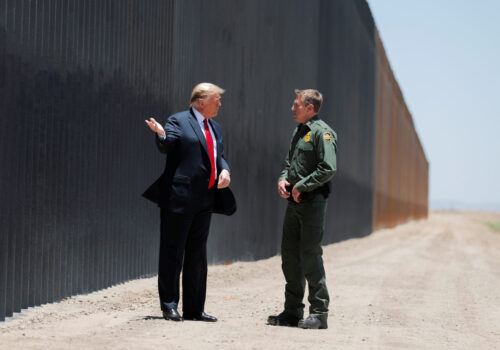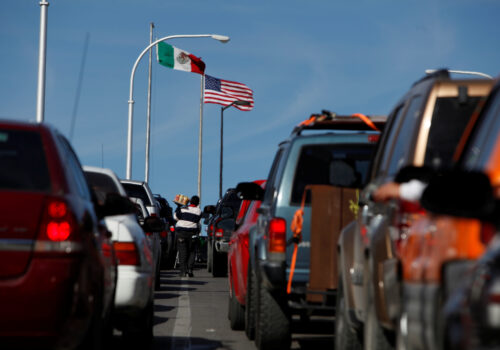What Trump’s mass deportation plans mean for Latin American countries
In its first weeks, the Trump administration has moved quickly to end Biden-era immigration and border policies as it lays the groundwork to curb mass migration at the southern US border and expand enforcement operations nationwide. Unlike during the first Trump administration, when legal battles thwarted efforts to curb immigration, the current administration’s overhaul has faced no serious domestic political resistance or show-stopping court orders, apart from its attempt to end birthright citizenship. Despite facing fewer domestic challenges, however, the second Trump administration may face greater international tension as it seeks to send millions of people to their countries of origin, most of them in Latin America.
A clear warning
The tension became clear on January 26, when Colombian President Gustavo Petro revoked authorization for two deportation flights set to land in Bogotá. In a social media post announcing his decision, Petro accused the United States of treating the deportees like criminals, as they were deported on a US military plane in which they were handcuffed. Trump quickly retaliated by threatening harsh trade tariffs, sanctions, and visa restrictions against Colombian officials. Petro then countered on social media that he would impose tariffs on the United States as well. The diplomatic showdown ended after intense backchannel discussions between the two countries forced Petro to reverse his decision.
The Colombian president’s attempt to block the Trump administration’s mass deportation plan highlights the broader challenge Latin American leaders face in adapting to a dramatic turn in US immigration policy. During the Biden administration, US officials sought to foster partnerships with Latin American governments and nongovernmental organizations to create safe migration transits and open legal pathways for migrants seeking economic opportunities in the United States. This dynamic led at least five million people from the Western Hemisphere to enter the United States through the southern border, with and without authorization, between 2021 and 2023. Trump’s return marks the end of this approach.
As Latin American leaders await further details of the Trump administration’s mass deportation plans, the US-Colombia standoff sends a clear warning that resisting the White House will come at a steep political cost. In Colombia, Petro’s failed attempt to block US repatriation flights led to the breakdown of his government coalition after the centrist Liberal Party withdrew two days later. His mismanagement of the crisis, which reportedly required intervention from former Colombian President Álvaro Uribe, gave many Colombians the impression that Petro was unprepared to handle this high-stakes diplomatic issue. Similarly, Honduran President Xiomara Castro’s attempt to rally Latin American nations against Trump’s mass deportation plan under the Community of Latin American and Caribbean States fell flat after other countries declined to attend her late January emergency meeting, forcing her to cancel it.
A struggle to adapt
The primary concern for Latin American leaders is the scale and scope of the Trump administration’s mass deportation plans. Estimates on the number of individuals who could be deported often focus on the approximately eleven million undocumented immigrants living in the United States. However, this figure fails to capture the full scope of the Trump administration’s deportation plans. The administration has made it clear that all foreign nationals who entered the United States during the Biden administration on temporary legal status will be expected to leave when their program status expires. So far, the administration has terminated parole programs, such as the Cuban, Haitian, Nicaraguan, and Venezuelan initiatives, which facilitated the entry of more than 528,000 people into the United States since January 2023. The Trump administration has also rescinded the previous administration’s extension of the temporary protected status designation for approximately 350,000 Venezuelan nationals, who will now lose their work authorization and may be ordered removed starting in April of this year.
A massive influx of deportations, particularly of individuals who have lived in the United States for years and have few ties with their countries of origin, will strain Latin American nations already struggling with sluggish economic growth and high unemployment rates. Many returning citizens may struggle to reintegrate after returning with greater employment skills and experience honed for the US economy but fewer economic opportunities or skills suited for where they are being sent. The sudden uprooting of people from the US labor force could also have a destabilizing impact on the deportees’ families and the local economies of their countries of origin, many of which rely on remittances for financial stability.
Left-wing Latin American leaders will likely find managing the shift in US immigration policy especially difficult. Despite their ideological opposition to Trump’s plans, they will need to cooperate with the United States to avoid retaliation, which would undermine their countries’ economic stability and erode public trust. But while compliance with US policy will be necessary to avoid an international diplomatic crisis, mass deportation could create domestic pressures that may invariably lead to a decline in public opinion of their governments. A larger number of young working-age people unable to leave their countries to work due to stricter US border security, coupled with a greater number of Latin Americans forced to return to their countries of origin, may deepen public disillusionment in the ability of governments to adequately address organized crime, corruption, and weak job markets.
Latin American governments also face the challenge of managing returnees who have committed violent crimes. If the scale of these deportations increases significantly, then it could put a strain on some Latin American countries, which will have to determine who is truly dangerous and whose violations are minor enough that they could safely be released. It is doubtful that any Latin American country has the resources to process the disposition of hundreds of thousands of returnees deemed criminals by the Trump administration. However, officials will need to assure their publics that dangerous criminals are not being released into the streets.
These factors could in turn push left-wing governments in the region to moderate their agendas—particularly their fiscal policies—to survive. Otherwise, they risk losing ground to centrist and conservative opposition parties. This dynamic may create a favorable situation for the Trump administration: Latin American governments will be forced to come into compliance with its top agenda of curbing migration to the United States. As a result, the political and economic pressures caused by the reduction of Latin American nationals in the US workforce could force the region’s governments to make long-overdue reforms aimed at reducing public spending and fostering greater economic growth.
Alicia Nieves is a legal expert in immigration and refugee law, specializing in humanitarian assistance and conflict rescue. She is a member of the Atlantic Council’s Counterterrorism Project and co-founder of the Gaza Family Project, an initiative of the Arab-American Civil Rights League (ACRL) dedicated to helping American families impacted by the Israel-Hamas war.
Further reading
Tue, Nov 19, 2024
Border security and the future of DHS: Will Trump 2.0 earn the public’s trust?
New Atlanticist By Thomas S. Warrick
The incoming US president has promised mass deportations, but there are three circumstances that could erode public support for the plans.
Fri, Jan 31, 2025
Beyond the border: Your briefing on US-Mexico commerce
Beyond the border By
The first edition of the Beyond the border: Your briefing on US-Mexico commerce newsletter.
Tue, Feb 4, 2025
Where do the Trump tariffs go from here?
Fast Thinking By
US tariffs on China went into effect today, while President Donald Trump paused levies on Mexico and Canada. Our experts explain who and what could be next.
Image: Migrants line up to leave the United States for Mexico after being deported across the Paso del Norte international border bridge, after US President Donald Trump promised mass deportation operation, as seen from Ciudad Juarez, Mexico January 23, 2025. REUTERS/Jose Luis Gonzalez


